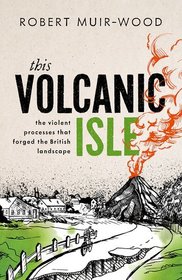
This Volcanic Isle
The Violent Processes that forged the British Landscape
-
10% KEDVEZMÉNY?
- A kedvezmény csak az 'Értesítés a kedvenc témákról' hírlevelünk címzettjeinek rendeléseire érvényes.
- Kiadói listaár GBP 20.00
-
9 555 Ft (9 100 Ft + 5% áfa)
Az ár azért becsült, mert a rendelés pillanatában nem lehet pontosan tudni, hogy a beérkezéskor milyen lesz a forint árfolyama az adott termék eredeti devizájához képest. Ha a forint romlana, kissé többet, ha javulna, kissé kevesebbet kell majd fizetnie.
- Kedvezmény(ek) 10% (cc. 956 Ft off)
- Kedvezményes ár 8 600 Ft (8 190 Ft + 5% áfa)
Iratkozzon fel most és részesüljön kedvezőbb árainkból!
Feliratkozom
9 555 Ft

Beszerezhetőség
Becsült beszerzési idő: A Prosperónál jelenleg nincsen raktáron, de a kiadónál igen. Beszerzés kb. 3-5 hét..
A Prosperónál jelenleg nincsen raktáron.
Why don't you give exact delivery time?
A beszerzés időigényét az eddigi tapasztalatokra alapozva adjuk meg. Azért becsült, mert a terméket külföldről hozzuk be, így a kiadó kiszolgálásának pillanatnyi gyorsaságától is függ. A megadottnál gyorsabb és lassabb szállítás is elképzelhető, de mindent megteszünk, hogy Ön a lehető leghamarabb jusson hozzá a termékhez.
A termék adatai:
- Kiadó OUP Oxford
- Megjelenés dátuma 2024. május 23.
- ISBN 9780198871620
- Kötéstípus Keménykötés
- Terjedelem368 oldal
- Méret 240x160x32 mm
- Súly 582 g
- Nyelv angol
- Illusztrációk 61 black and white figures 564
Kategóriák
Rövid leírás:
This Volcanic Isle explores the rich geological history of the British Isles over the past 66 million years, since the disappearance of the dinosaurs. From the Isle of Wight needles to the Giant's causeway to the Sticklepath faultline in Devon, this book recounts how earthquakes and eruptions, plumes and plate boundaries, built the British Isles.
TöbbHosszú leírás:
From the natural geometry of the Giant's Causeway to the sarsen slabs used to build Stonehenge, we are surrounded by evidence for the extraordinary geological forces that shaped the British Isles.
Running coast to coast through Devon is 'Sticklepath', Britain's 'San Andreas', a geological fault with the two sides displaced horizontally by several kilometres, all within the recent geological past. The Sticklepath Fault is just one manifestation of the rich tectonic history of the British region since the asteroid collision that ended the reign of the dinosaurs, 66 million years ago. Raised out of the Chalk Sea, the original Albion was a thickly forested island a thousand kilometres long, surrounded by chalk cliffs, punctuated with great volcanoes, and the site of two trial 'spreading ridge' plate-boundaries. As the volcanoes shifted west, and Greenland separated from Europe, the wind-blown volcanic ash laid the strata on which London was founded. The vertical Needles, known to every Isle of Wight sailor, are part of the northern foothills of the Pyrenees. When the collision subsided, rifting created a garland of Celtic lakes from Brittany to the Outer Hebrides.
In This Volcanic Isle Robert Muir-Wood explores the rich geological history of the British Isles, and its resulting legacy. Along the way he introduces the personalities who shared a fascination for Britain's tectonic history, including Charles Darwin the geologist, Tennyson the science-poet, and Benoit Mandelbrot, the pure mathematician who labelled the west coast of Britain a fractal icon. Here is the previously untold story of how earthquakes and eruptions, plumes and plate boundaries, built the British Isles.
This Volcanic Isle masterfully unpeels the skin of the British landscape to reveal a torrid and turbulent past. It is land famed for its geological antiquity, and yet in journeying through its last 66 million years it is the enduring youthfulness of tectonic, seismic and volcanic actions that constantly surprises and enthrals. Local places and familiar vistas are interwoven with planetary processes in a beautifully written account of how our appreciation of the natural world around us can be immeasurably enhanced by viewing it through rock-tinted spectacles.
Tartalomjegyzék:
Archi-tectonics
The Big Tilt
Age of Fire
Caught between the Plates
Age of Ice
Highland Fling
The Rocky Road
Index






